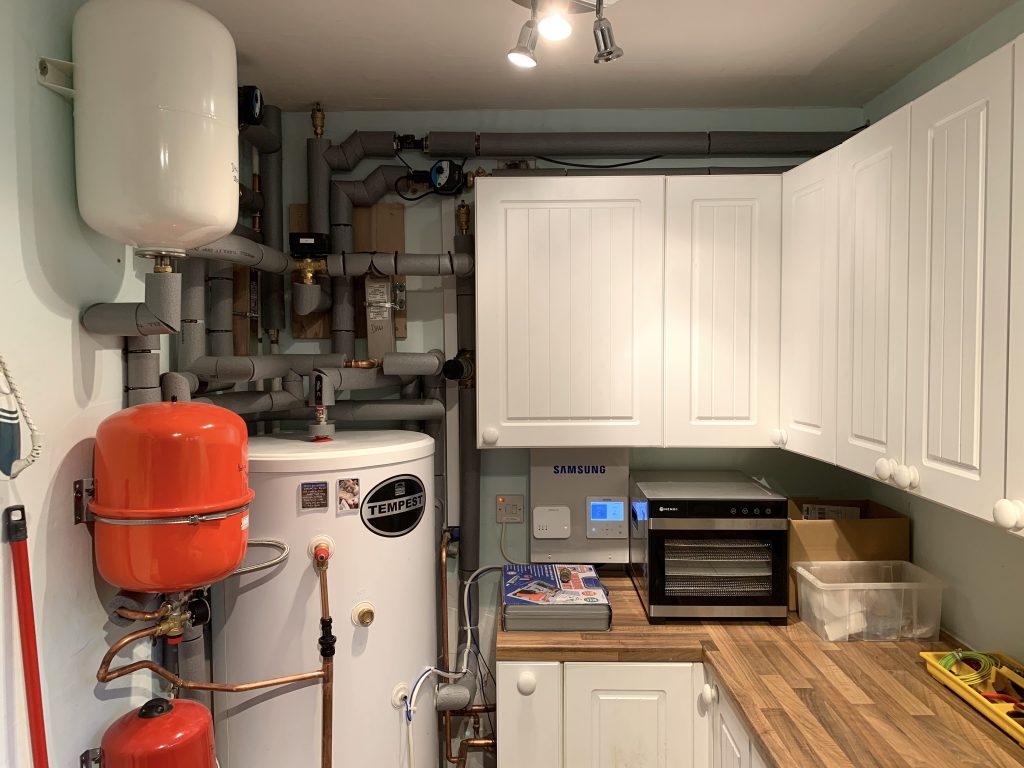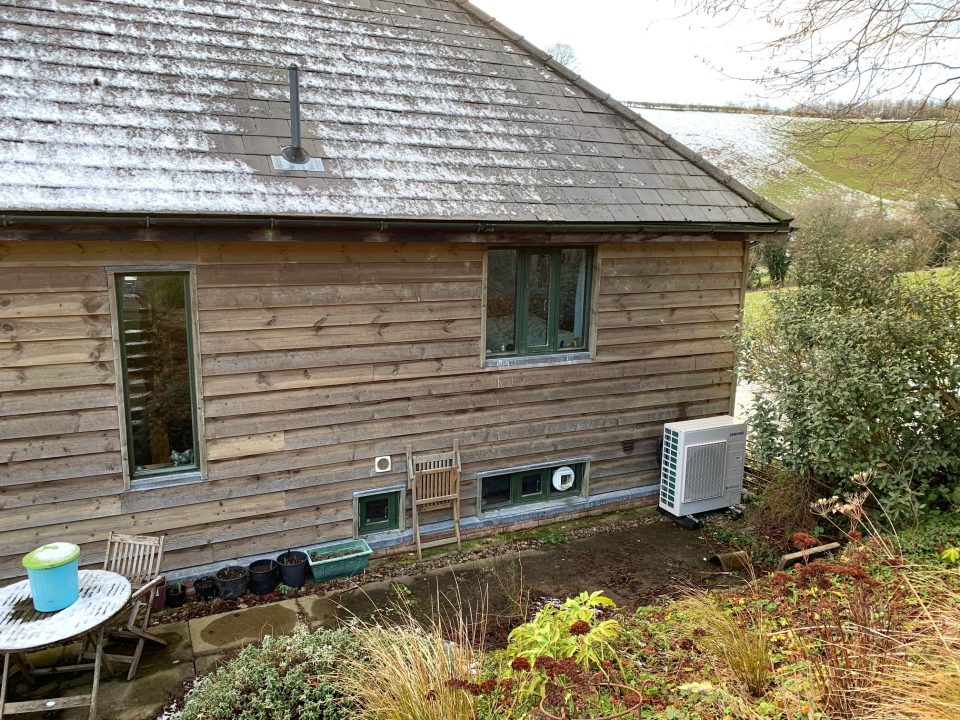Our air source heat pump (ASHP) journey began in 2020 when we decided it was finally time to get rid of our fossil fuel guzzling, leaking, old oil boiler and replace it with something more environmentally-friendly.
We’d never heard of ASHPs until our son moved into a new build house a few years ago that had one installed. Outside, in the back garden, against the house, there was what looked like an air conditioning unit, which purred away. It wasn’t noisy, but you could definitely hear it.
There was a monstrous cylinder inside the house with an expansion tank or two, some pumps, valves and controls and pipework. There was a lot of it and it was housed in a large cupboard, which fitted surprisingly well into what was a relatively small, one bedroom house.
In terms of how it operated, our son was told that once it was set up he should just leave it alone. It would be serviced once a year by the Housing Association, but other than that he should just let it get on with it, which is what he did.
It did, indeed, seem to run without any problems. The house was always warm and hot water was plentiful. There were two thermostats, one on each floor, which he could adjust for the changing seasons. He paid around £38 a month in electricity bills. The unit was a Mitsubishi, but I can’t remember any other details.
So it made sense, having seen one in action, for us to go down the ASHP route. We had looked into the government’s Renewable Heat Incentive (RHI) scheme and although not as generous as it used to be (which seems strange, when we should be incentivising renewable energy schemes as much as possible, in the face of the climate crisis) we still felt it was worth pursuing.
We would have to pay for the ASHP and installation upfront, but could then claim back around £7,000 of the cost over seven years. So you need to be in a position to have around £10,000 spare to be able to qualify, which excludes a lot of people, including those who would probably benefit the most. We’d been left some money, so we were lucky enough to be able to do this, but I appreciate that most people wouldn’t be.
We did what people always tell you to do, but what most people (including us usually) don’t, and got three different quotes from local companies. They all came out at around the same figure so the one we chose was down to us both liking the salesperson, who genuinely knew what he was talking about and seemed to really get the importance to us, of choosing a ‘green’ system. Fortuitously, it also happened to be the cheapest quote.
The salesman – we’ll call him Pete – explained that we’d need an EPC (Energy Performance Certificate) for the house that was less than two years old. Ours was done five years ago when we bought the house, and it was rated D. So we arranged to have another one carried out at a cost of £65.
He also said that we would need to make sure that the loft insulation was a minimum of 270mm depth. This rang a few alarm bells, as the loft is 90% boarded and we knew the insulation was only 150mm deep.
To increase this involved us buying extra insulation. We used sheep’s’ wool and some loft legs to raise the height of the boards, then paying someone to take up all the boards, lay the additional insulation and re-lay the boards. That cost us about £2,000 for materials and labour.
The system we chose was a Samsung 9kW mono unit. It needs its own electrical circuit, so you need to make sure that your consumer unit has the capacity for an additional circuit. A separate meter is fitted in the consumer unit, which monitors the electricity use for the ASHP only, so you can work out exactly how much electricity the pump is using.
Then along came Covid and everything ground to a halt for several months. This pause turned out to be beneficial as the Green Homes Grant was launched by the government later in 2020 and we qualified for it.
This meant two things. One, we were extremely glad to already be ‘in the system’ as there was a huge demand for a limited number of suitably accredited installers and two, that having navigated the RHI, we now had to get to grips with the GHG scheme.
It’s quite a complicated system, which can only be accessed online, thereby excluding people without access to the Internet and those who are not comfortable using technology – likely to be those living in fuel poverty and most in need of help. They would qualify for £10,000 towards the cost but that’s not much good if you are unable to apply.
There are primary and secondary measures that you can claim for – this is worth checking thoroughly as there are quite a few rules and regulations around what you can and can’t apply for. I’m glad we only applied for one measure.
We applied for our voucher in November 2020. Part of the application was to supply a copy of one quote – it says you need to get three quotes but they only actually asked for one. You also need to know your installer’s MCS accreditation number. Because we applied as soon as the scheme was launched, our voucher was approved in early December, after being asked for additional information, which I had already supplied.
So then it reached the stage where we could actually ask the installers to start work. I know many people have struggled to find local installers, as many are now booked up for months, so again, it was good that we were already in their system. We had a site survey done and the installers arrived on the due date.
On the whole, it went pretty much to plan with just a few glitches. We’d been told we’d be without hot water for a day, it turned out to be two but that was fine. We had been advised to have a copper tank, due to the hardness of our water, but unfortunately that information got lost between the salesman and the installers and they turned up with a stainless steel one. They have fitted that and a copper one is on order and they will be swapped in due course. The cylinder and associated expansion tanks, valves, pumps, etc., take up quite a lot of space.
This is all in our utility room, so not too much of a problem, but in a kitchen it would take up considerably more space than a boiler. In hindsight, we would have sacrificed some cupboard and worktop space to have everything run across the back wall, as that would then have been easier to screen off.

The heat pump itself has been installed at the back of the house, below a guest bedroom window. Although the noise isn’t intrusive, when you are in the garden you can hear it quite clearly from the bedroom. We’re yet to see if that becomes an issue but I’d suggest having it installed away from occupied rooms, if possible.
Finance wise, we paid a 25% deposit when we confirmed our order with the installation company. We paid a further 25% following installation and the balance will be paid, direct to the installers by the GHG. We have now received all our documentation (guarantees, compliance documents, electrical safety certificate, etc.) for the work done and have applied to redeem our GHG voucher – it’s not very clear about what figures to put in but we’ve emailed it off and not heard back, so presumably, we’ve done it correctly.
Interestingly, we can apparently also still claim the RHI for this installation. I haven’t started that process yet but you have up to a year, following installation, to claim. As part of the application, you have to state that you have received a GHG voucher but if it is as it seems, we should be able to claim back the 50% that we paid for the ASHP, with the repayments being paid to us, over 7 years. This is where we are at, now.
On an interesting and related note, on February 13, 2021, the government announced that only £71 million of the £1.5 billion promised to householders for the scheme had been given out – just 5%. The grants have been extended to run to March 2022 because of delays in administering them. However, it has to be said that the remainder of this financial year’s money will not be rolled over into 2022. Instead, a much smaller amount, just £320 million, will be available in the next financial year.
This seems like a very backwards step to us. I also found out that the scheme is being run by an American global consulting firm, which I wasn’t aware of.



I love this article and good choice of heat pump.